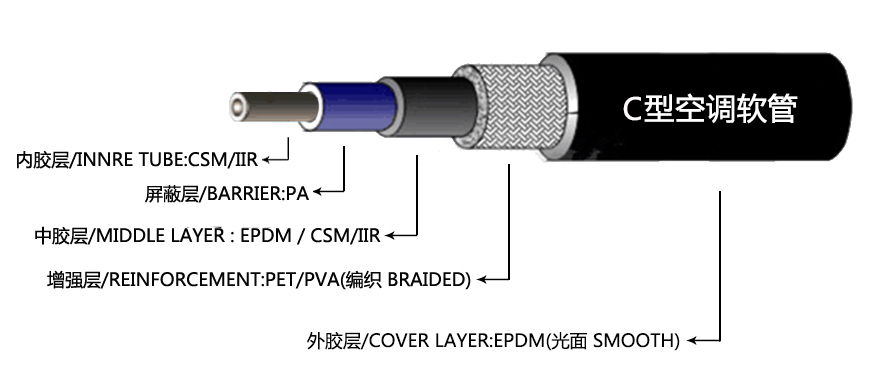Understanding the Use and Benefits of R134a Recharge Hoses for AC Systems
Understanding R134a Recharge Hoses A Comprehensive Guide
Refrigerants play a crucial role in the functioning of air conditioning systems, and R134a is one of the most widely used refrigerants in both automotive and household applications. As with any mechanical system, regular maintenance is essential to ensure optimal performance, and part of this maintenance includes recharging the refrigerant. A pivotal tool in this process is the R134a recharge hose. In this article, we will explore the purpose, types, and proper use of R134a recharge hoses while also highlighting safety considerations.
What is R134a?
R134a, or tetrafluoroethane, is a hydrofluorocarbon (HFC) refrigerant that replaced the ozone-depleting R12 refrigerant. Used primarily in automotive air conditioning systems, R134a is favored for its lower environmental impact, energy efficiency, and stability. However, its effectiveness can diminish over time due to leaks or system inefficiencies, necessitating the need for recharging.
The Purpose of Recharge Hoses
Recharge hoses, also known as service hoses, serve as the conduit through which the refrigerant is added to the air conditioning system. An R134a recharge hose typically consists of several key components
1. Hose Made from durable materials to withstand the pressures of refrigerant transfer. 2. Fittings Designed specifically to connect to R134a service ports (the low-side and high-side ports). 3. Gauge Many hoses are equipped with pressure gauges that allow users to monitor the refrigerant pressure in the system, ensuring that the recharge process is safe and effective.
Types of R134a Recharge Hoses
Recharge hoses come in various styles, catering to different needs and levels of expertise
. The primary types include1. Standard Recharge Hoses These are basic hoses designed for casual users or DIY enthusiasts. They typically come with a gauge and simple connection fittings.
2. Professional Service Hoses These are more robust and designed for frequent use by technicians. They have higher pressure ratings, improved durability, and often feature additional safety mechanisms.
3. Manifold Gauge Sets A manifold gauge set includes recharge hoses along with multiple gauges for both high-side and low-side pressures. These are commonly used by professionals and provide more detailed readings, allowing for a comprehensive diagnosis of the air conditioning system.
How to Use an R134a Recharge Hose
r134a recharge hose

Using an R134a recharge hose requires a careful approach to ensure safety and efficiency. Here’s a step-by-step guide
1. Preparation Ensure that the vehicle is turned off and parked on a level surface. Gather your tools, including the recharge hose, a can of R134a refrigerant, and safety equipment (gloves and goggles).
2. Locate Ports Identify the low-pressure service port on the air conditioning system. This is typically a smaller port that is easily accessible under the hood.
3. Connect the Hose Attach the blue (low-pressure) hose from the recharge kit to the low-pressure service port. Ensure a secure fit to prevent leaks.
4. Check the Pressure With the engine running and the AC set to the maximum setting, check the gauge on the recharge hose. This will provide a reading of the current system pressure.
5. Recharge the System If the pressure is low, proceed to attach the refrigerant can to the hose. Open the valve on the can to allow R134a to flow into the system. It is important to follow the manufacturer’s guidelines regarding the volume of refrigerant to add.
6. Monitor While Charging Keep an eye on the gauge to avoid overcharging, which can damage the system. Stop adding refrigerant when the correct pressure is reached.
7. Disconnect and Test Once the system is charged, disconnect the recharge hose, replace the port cap, and test the air conditioning system for proper cooling.
Safety Considerations
While recharging R134a systems can be a straightforward process, safety should always be a priority. R134a is not flammable, but it can displace oxygen in confined spaces, leading to asphyxiation risks. Always work in a well-ventilated area, wear appropriate personal protective equipment, and never attempt to recharge a system that shows evidence of a leak.
Conclusion
The R134a recharge hose is an essential tool for maintaining the efficiency of air conditioning systems. By understanding its purpose, types, and proper usage, individuals can ensure that their systems function optimally while minimizing the risks associated with refrigerant handling. Proper maintenance through regular recharging not only prolongs the life of your air conditioning system but also contributes to a more environmentally friendly approach to refrigerant use. Whether you're a DIY enthusiast or a professional technician, mastering the use of an R134a recharge hose is a valuable skill that will serve you well in maintaining comfortable and efficient cooling solutions.
-
Ultimate Spiral Protection for Hoses & CablesNewsJun.26,2025
-
The Ultimate Quick-Connect Solutions for Every NeedNewsJun.26,2025
-
SAE J1401 Brake Hose: Reliable Choice for Safe BrakingNewsJun.26,2025
-
Reliable J2064 A/C Hoses for Real-World Cooling NeedsNewsJun.26,2025
-
Heavy-Duty Sewer Jetting Hoses Built to LastNewsJun.26,2025
-
Fix Power Steering Tube Leaks Fast – Durable & Affordable SolutionNewsJun.26,2025

